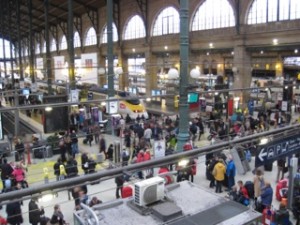A trip last week to Normandy provided a perfect opportunity to reflect on the differences between British and French railways.
The default view would have you believe that Britain’s railways are the poor relation and that everything is France is wonderful. In reality, French railways are far from perfect.
I travelled from London St Pancras to Lille by Eurostar, changing there to a TGV service for the run into Paris Nord. From there, it was one stop by RER to St Lazaire for an Intercity service to Caen.
I opted for first class in France and my TGV provided a large and comfortable seat. There were a few other passengers in the coach so it was neither empty nor crowded. A trolley service passed twice before its host settled down into an FC seat. On sale were the usual hot and cold drinks. In Britain on long-distance inter-city journeys you could reasonably expect complimentary hot drinks and maybe a packet of biscuits. In France, you must pay.
However, the journey was as quick as you’d expect a TGV to be and I was soon passing the huge amount of graffiti that marks the approach to France’s capital city. My RER transfer was simply enough (although the ticket barriers are not suited to passengers with luggage and not all lifts were working) and I reached St Lazaire around midday. It’s a big station with many platforms and serves suburban and inter-city destinations. There were plenty of people waiting but few trains. One service from Le Havre was running four hours late but mine to Caen left on time.
Running on classic lines, I was struck by the amount of railway the French have. My journey was punctuated by large yards of electrified sidings, rakes of stock and clusters of waiting locomotives of varying ages. Yet Caen’s service appeared to be two-hourly and I didn’t pass many other trains. There was certainly little freight but I passed several factories that still had connections. Biggest of them was a Peugeot works and this did have flat wagons loaded with vehicles in its exchange sidings. A nearby Renault factory even had its own signalbox (‘Poste’ in French).
Classic French first class provides less than TGV first class. There was no trolley and the seats appeared similar to second class, albeit with armrests.
My return from Caen coincided with a French holiday so the station’s seven or so platforms were particularly quiet. A couple of trains per hour were posted on the departures board, serving destinations such as Paris, Cherbourg and Lisieux. My journey to Paris was not troubled by any ticket checks and neither Caen nor St Lazaire have barriers.
I left Caen five minutes late and was slowed along the way by temporary speed restrictions. Arrival in Paris was on time almost exactly two hours later.
Paris Nord remains its cluttered self with armed soldiers, beggars, porters and electric service carts weaving their way through the hordes of waiting passengers. ‘Hall Londres’ provided me a good vantage point from which to view proceedings before I ventured into the crowded Eurostar departure lounge that’s been bolted onto the side of the trainshed.
It strikes me that France has an under-used railway network. In many cases, it appears unkempt. Broken lifts and stationary escalators reinforce this view.


Paris Nord station on November 1
In contrast, Britain has ploughed considerable sums of money into rolling stock and stations. It runs more frequent services and provides better on-board service than its near neighbours in France.